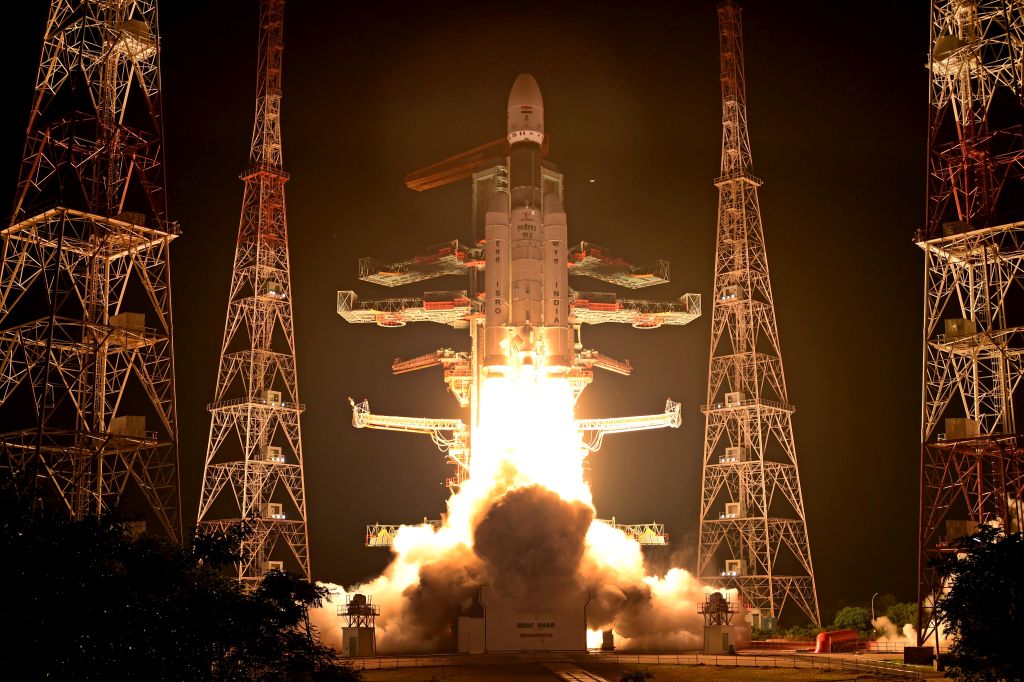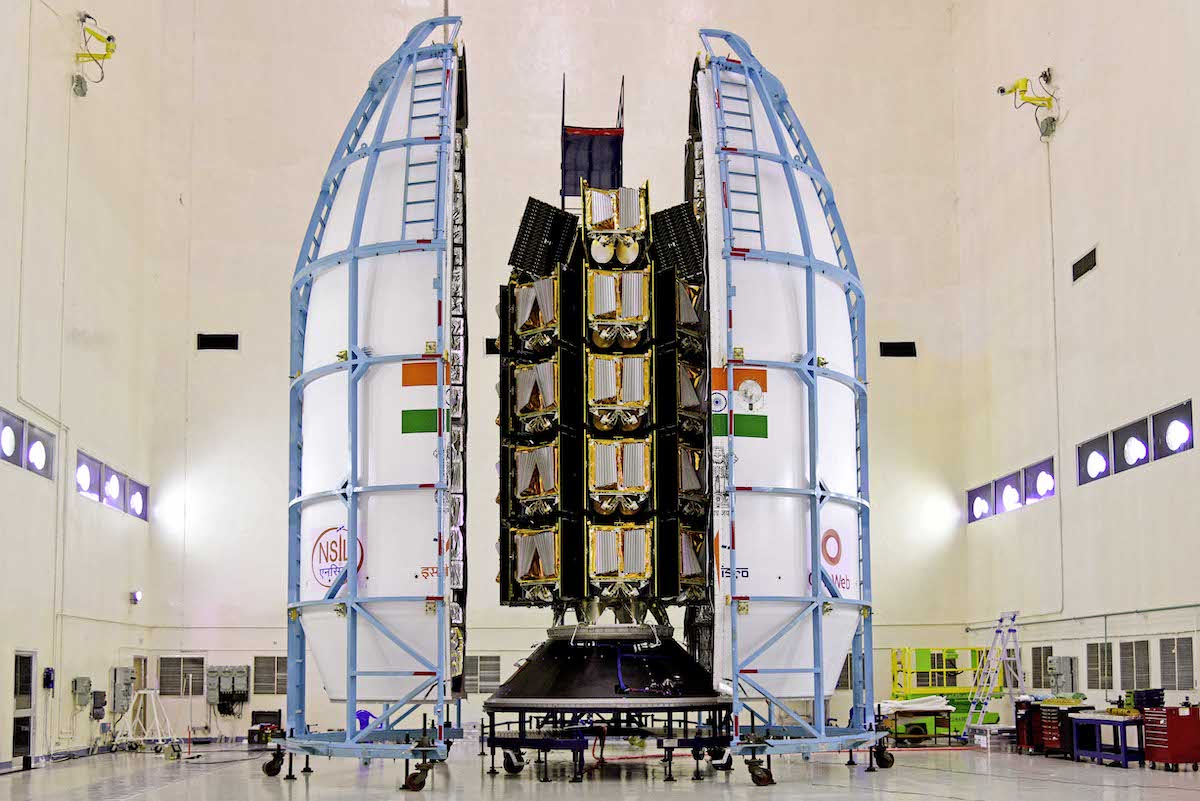Space News & Blog Articles
OneWeb celebrates successful launch on Indian rocket
 India’s GSLV Mk.3 rocket, also called LVM3, lifts off with 36 OneWeb internet satellites. Credit: ISRO
India’s GSLV Mk.3 rocket, also called LVM3, lifts off with 36 OneWeb internet satellites. Credit: ISRO
OneWeb confirmed it established contact with all 36 new satellites launched Saturday on top of India’s most powerful rocket, resuming the deployment of the company’s fleet of internet relay platforms after suspending launches with Russia earlier this year.
The mission Saturday was one of five rocket launches OneWeb needs to complete the first-generation constellation. OneWeb contracted SpaceX for three of the remaining missions, and inked a deal with NewSpace India Limited, the commercial arm of India’s space agency, for two flights.
“Today’s launch is a significant milestone for OneWeb,” said Sunil Bharti Mittal, executive chairman of OneWeb, and the and the billionaire founder of Bharti Enterprises, OneWeb’s largest shareholder. “This new phase of our launch programme from India brings us a step closer to not only enhancing our global coverage but also delivering connectivity in India and South Asia, particularly to the communities who need it most.”
The 36 OneWeb satellites lifted off from the Satish Dhawan Space Center on India’s east coast at 2:37:40 p.m. EDT (1837:40 GMT) Saturday on top of a Geosynchronous Satellite Launch Vehicle Mk.3 rocket, also called the LVM3. The GSLV Mk.3 is India’s most powerful launch vehicle, and the OneWeb flight was the first commercial mission to use it.
The 143-foot-tall (43.5-meter) rocket fired two powerful S200 solid rocket boosters to begin the climb off the pad at the Indian spaceport, located on Sriharikota Island about 50 miles (80 kilometers) north of Chennai. The GSLV Mk.3 headed southeast over the Bay of Bengal, riding 2.2 million pounds of thrust from the two solid-fueled boosters before igniting two core stage Vikas engines nearly two minutes into the mission.
With the hydrazine-fueled core engines firing, the solid rocket boosters burned out and jettisoned a little more than 2 minutes into the flight. The nose cone on top of the rocket jettisoned moments later to reveal the OneWeb satellites mounted to a dispenser structure. The core stage separated and the cryogenic third stage ignited a hydrogen-fueled engine to more than 10 minutes and accelerate the OneWeb satellites to orbital velocity.
The OneWeb satellites began separating from their dispenser on the GSLV’s upper stage at T+plus 19 minutes, 45 seconds. The spacecraft deployed in groups of four over the following 90 minutes. The 36 satellites totaled
Massimiliano Ladovaz, OneWeb’s chief technology officer, tweeted late Saturday that ground controllers established contact with all 36 satellites after deployment from the Indian launch vehicle. U.S. military tracking data confirmed the rocket placed the satellites into an on-target orbit with a peak altitude of about 373 miles (601 kilometers) and an inclination of 87.4 degrees to the equator.
The OneWeb satellites, each weighing about 325 pounds (147.5 kilograms at launch), were expected to deploy solar panels and activate xenon ion thrusters to maneuver into their operational orbit at an altitude of 745 miles (1,200 kilometers).
OneWeb’s satellites are built in a factory just outside the gates of NASA’s Kennedy Space Center in Florida by a joint venture between OneWeb and Airbus Defense and Space. The satellites are are designed to beam low-latency broadband internet signals to customers around the world. Based in London, OneWeb is one of several operators either already launching large fleets of internet satellites, or planning to begin launches soon.
SpaceX has launched more than 3,500 Starlink internet satellites using the company’s own reusable Falcon 9 rocket. OneWeb has launched 428 satellites of a planned first-generation constellation of 648 spacecraft using 13 Russian Soyuz rockets purchased through Arianespace, the French launch services provider. And Amazon plans to launch its first two prototype internet satellites of a planned constellation of 3,236 spacecraft next year on the first flight of United Launch Alliance’s new Vulcan rocket.
Liftoff of the GSLV Mk.3 rocket with 36 OneWeb internet satellites, marking the first commercial launch for India’s most powerful rocket. https://t.co/gO8rMQKVD2 pic.twitter.com/0pvIgnFtsv
— Spaceflight Now (@SpaceflightNow) October 22, 2022
But OneWeb’s launch plans were interrupted earlier this year after Russia’s invasion of Ukraine.
Arianespace was on the hook with OneWeb for six more Soyuz launches from the Baikonur Cosmodrome in Kazakhstan, including a 14th launch that was set to take off in March. But Russia’s space agency set conditions on the mission after rolling the rocket and the OneWeb satellites to a launch pad at Baikonur, including a demand that the UK government give up its stake in OneWeb.
The UK government declined, and OneWeb announced March 3 it was suspending launches from Baikonur. OneWeb reported a loss of $229.2 million on its financial statements as a result of the termination of the planned Soyuz launch in March. The financial charge also covers losses associated with the postponement of subsequent Soyuz missions, and the loss of 36 satellites stranded in Kazakhstan and not returned to OneWeb by Russia, which runs the Baikonur Cosmodrome.
Less than a month after Soyuz launches were suspended, OneWeb announced an agreement with SpaceX to launch some of its remaining satellites. OneWeb finalized a similar agreement with New Space India Limited, the commercial arm of India’s space agency, for launches on Indian rockets.
The contract with SpaceX was surprising to many satellite industry watchers because OneWeb is an indirect competitor in broadband market. SpaceX sells Starlink service directly to consumers, while OneWeb sells to enterprises and internet service providers to provide connectivity for entire businesses or communities.
There are three Falcon 9 flights planned for OneWeb into polar orbit from Cape Canaveral — a short drive from OneWeb’s factory on Florida’s Space Coast — later this year and early next year. OneWeb has procured two launches on India’s GSLV Mk.3 rocket, the first of which blasted off Saturday.
 Thirty-six OneWeb internet satellites are mounted on a dispenser inside the nose cone of India’s GSLV Mk.3 rocket. This photo was taken earlier this month during encapsulation inside the rocket’s payload fairing. Credit: ISRO
Thirty-six OneWeb internet satellites are mounted on a dispenser inside the nose cone of India’s GSLV Mk.3 rocket. This photo was taken earlier this month during encapsulation inside the rocket’s payload fairing. Credit: ISRO
OneWeb and its new launch providers completed preparations to resume the launch campaign within months.
“Usually a launch integration takes about a year to get ready,” Ladovaz said. “There’s a lot of analysis to get done … We had to do all that in less than six months. I think we are breaking a record here.”
OneWeb said earlier this year the three Falcon 9 flights will be equivalent to the launch capacity of four Soyuz rockets, which carried as many as 36 OneWeb satellites on each flight. That would mean SpaceX will launch around 48 OneWeb spacecraft on each mission, although the exact figures haven’t been confirmed.
The five additional launches should be complete in the first half of next year, with all the satellites entering commercial service by the end of 2023, according to OneWeb.
The launch Saturday was also the first commercial flight of India’s GSLV Mk.3, or LVM3, rocket. It was the fifth flight of a GSLV Mk.3 rocket overall. The stack of 36 OneWeb satellites, combined with their dispenser made in Sweden by Beyond Gravity, weighed about 12,800 pounds (5.8 metric tons) at liftoff, the heaviest payload ever delivered to orbit by an Indian rocket.
“GSLV Mk.3 has made a most remarkable entry into the commercial launch service market,” said D. Radhakrishnan, chairman and managing director of NSIL. “I’m extremely thankful for OneWeb for having faith in us, in our launch, and the most professional and technical capability of team ISRO.”
“With this mission we have shown the entire world how to contract and execute a mission in less than three to four months,” he said.
Mittal, head of OneWeb’s largest investor, told Indian media that OneWeb paid NSIL around $240 million for the two GSLV Mk.3 missions.
“Today my dream of having an Indian element in the OneWeb constellation has been realized,” Mittal said. “This launch with ISRO and NSIL opens up the space sector in India with the possibility of billions of dollars flowing into the country.”
OneWeb kept busy developing and testing ground systems and user terminals during the break in launches this year.
Eutelsat and OneWeb also announced plans to merge in July, bringing together OneWeb’s network of internet satellites in low Earth orbit with Eutelsat’s fleet of larger video, data relay, and broadband platforms in geostationary orbit.
The switch in launch vehicles for OneWeb’s remaining deployment missions was not the first hurdle the company has overcome. OneWeb weathered bankruptcy in 2020, and emerged under the majority ownership of Bharti Global, an Indian telecom company, and the UK government.
Founded by entrepreneur Greg Wyler in 2012, OneWeb is already planning an even larger constellation called Gen 2 that the company says could be ready for commercial service by early 2028. Pending the conclusion of the merger, Eutelsat’s resources will help OneWeb finance its Gen 2 constellation. OneWeb’s other current shareholders include Bharti, the UK government, and the Japanese company Softbank, among others.
OneWeb signed a settlement agreement with Arianespace earlier this year after the suspension of Soyuz launches. The terms of the settlement are confidential, Arianespace said, but could allow Arianespace to resume launches for OneWeb in the future on Europe’s new Ariane 6 rocket for the second generation of the OneWeb constellation.
OneWeb also announced an agreement with Relativity Space in June for multiple Gen 2 satellite launches beginning as soon as 2025 on the launch company’s next-generation reusable Terran R rocket.
This email address is being protected from spambots. You need JavaScript enabled to view it. the author.
Follow Stephen Clark on Twitter: @StephenClark1.
When you subscribe to the SpaceZE News Feed, we will send you an e-mail when there are new updates on the site so you wouldn't miss them.

